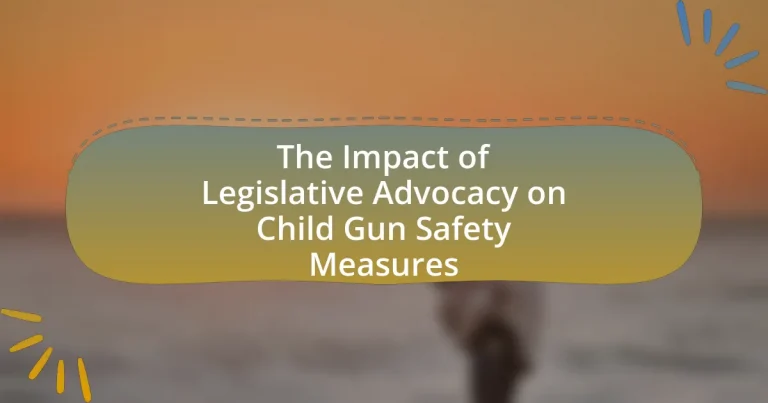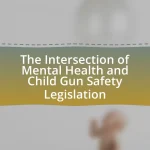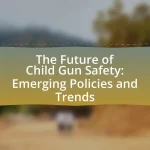The article examines the significant impact of legislative advocacy on child gun safety measures, highlighting how advocacy efforts lead to the enactment of laws that regulate firearm access and usage among minors. It discusses the correlation between stricter gun laws and reduced rates of unintentional shootings and firearm-related deaths among children, supported by research from organizations like the American Academy of Pediatrics. Key components of effective advocacy, such as stakeholder engagement, evidence-based policy development, and coalition building, are outlined, along with the challenges advocates face in promoting child gun safety legislation. The article also emphasizes the role of advocacy groups in raising awareness and influencing policy, while providing insights into the effectiveness of specific legislative measures aimed at enhancing child safety.

What is the Impact of Legislative Advocacy on Child Gun Safety Measures?
Legislative advocacy significantly enhances child gun safety measures by promoting the enactment of laws that regulate firearm access and usage among minors. For instance, states that have implemented stricter gun laws, such as safe storage requirements and background checks, have seen a reduction in unintentional shootings and gun-related incidents involving children. Research from the American Academy of Pediatrics indicates that states with comprehensive gun safety legislation experience a 30% lower rate of firearm-related deaths among children compared to those without such measures. This correlation underscores the effectiveness of legislative advocacy in fostering safer environments for children regarding gun ownership and usage.
How does legislative advocacy influence child gun safety policies?
Legislative advocacy significantly influences child gun safety policies by mobilizing public support and shaping legislative agendas. Advocacy groups, such as the Everytown for Gun Safety and the Brady Campaign, utilize data-driven campaigns to highlight the risks of gun violence to children, leading to increased awareness and urgency among lawmakers. For instance, after advocacy efforts in states like California and New York, legislation was enacted to implement stricter safe storage laws and background checks, directly correlating with reduced incidents of child gun-related injuries. These efforts demonstrate how organized advocacy can effectively drive policy changes that enhance child safety in relation to firearms.
What are the key components of legislative advocacy in this context?
The key components of legislative advocacy in the context of child gun safety measures include stakeholder engagement, evidence-based policy development, coalition building, and effective communication strategies. Stakeholder engagement involves identifying and involving individuals and organizations affected by gun safety issues, such as parents, educators, and healthcare professionals, to ensure diverse perspectives are represented. Evidence-based policy development relies on research and data to inform legislative proposals, demonstrating the effectiveness of specific measures in reducing child gun injuries. Coalition building focuses on uniting various groups, including advocacy organizations and community leaders, to amplify the message and increase influence. Effective communication strategies are essential for conveying the importance of child gun safety to lawmakers and the public, utilizing clear messaging and compelling narratives to drive action. These components collectively enhance the impact of legislative advocacy efforts aimed at improving child gun safety measures.
How do these components interact with child gun safety measures?
Legislative advocacy components, such as policy proposals, community engagement, and educational initiatives, interact with child gun safety measures by promoting awareness and establishing regulations that protect children from gun-related incidents. For instance, advocacy efforts have led to the implementation of laws requiring safe storage practices for firearms, which directly reduce the risk of accidental shootings among children. Research indicates that states with stricter gun storage laws experience lower rates of unintentional firearm deaths among minors, highlighting the effectiveness of these advocacy-driven measures in enhancing child safety.
Why is child gun safety a critical issue in legislative advocacy?
Child gun safety is a critical issue in legislative advocacy because it directly impacts the prevention of firearm-related injuries and deaths among children. Statistics indicate that in the United States, approximately 3,000 children are killed or injured by guns each year, highlighting the urgent need for effective legislation. Legislative advocacy aims to implement measures such as safe storage laws, background checks, and educational programs that can significantly reduce these incidents. Research from the American Academy of Pediatrics shows that states with stricter gun laws have lower rates of firearm deaths among children, reinforcing the importance of legislative action in promoting child safety.
What statistics highlight the importance of child gun safety?
In the United States, approximately 4.6 million children live in homes with at least one loaded and unlocked firearm, highlighting the critical need for child gun safety measures. Research indicates that unintentional shootings involving children occur at a rate of about 500 incidents annually, with nearly 100 resulting in death. Furthermore, a study published in the journal “Pediatrics” found that children aged 0-14 are more likely to die from gun-related injuries than from any other cause of injury. These statistics underscore the urgent necessity for legislative advocacy aimed at improving child gun safety measures to prevent tragic outcomes.
How do public perceptions shape legislative efforts for child gun safety?
Public perceptions significantly influence legislative efforts for child gun safety by creating pressure on lawmakers to respond to constituents’ concerns. When a substantial portion of the public expresses fear or disapproval regarding child access to firearms, legislators often feel compelled to introduce or support measures aimed at enhancing gun safety for children. For instance, following high-profile incidents of gun violence involving children, public outcry has led to the introduction of laws such as safe storage requirements and background checks for gun purchasers. Research indicates that states with higher public support for gun control measures tend to enact stricter gun laws, demonstrating a direct correlation between public sentiment and legislative action.
What role do advocacy groups play in promoting child gun safety measures?
Advocacy groups play a crucial role in promoting child gun safety measures by raising awareness, influencing policy, and providing education on safe firearm practices. These organizations, such as the Brady Campaign to Prevent Gun Violence and Everytown for Gun Safety, actively campaign for legislation that mandates safe storage practices and promotes child access prevention laws. For instance, research indicates that states with stronger child access prevention laws experience lower rates of unintentional firearm injuries among children. By mobilizing communities, conducting research, and collaborating with lawmakers, advocacy groups effectively contribute to the development and implementation of policies aimed at reducing gun-related incidents involving children.
Which organizations are most influential in this advocacy?
The most influential organizations in the advocacy for child gun safety measures include Everytown for Gun Safety, the Brady Campaign to Prevent Gun Violence, and the Giffords Law Center to Prevent Gun Violence. Everytown for Gun Safety, founded in 2014, has mobilized millions of supporters and advocates for stronger gun laws, emphasizing the need for child safety in their campaigns. The Brady Campaign, established in 1974, focuses on reducing gun violence through legislative action and public awareness, highlighting the risks firearms pose to children. The Giffords Law Center, named after former Congresswoman Gabby Giffords, works on policy initiatives aimed at preventing gun violence, particularly in relation to protecting children. These organizations have successfully influenced legislation and public opinion through extensive research, advocacy campaigns, and grassroots mobilization efforts.
How do these organizations mobilize public support for legislative changes?
Organizations mobilize public support for legislative changes by employing strategic communication, grassroots campaigns, and coalition-building efforts. These methods engage the community, raise awareness about child gun safety issues, and encourage public participation in advocacy. For instance, organizations like Everytown for Gun Safety utilize social media platforms to disseminate information and mobilize supporters, resulting in increased public pressure on lawmakers. Additionally, research from the Harvard Kennedy School indicates that grassroots movements can significantly influence legislative outcomes by demonstrating widespread public concern, thereby compelling legislators to act in favor of proposed measures.
How can legislative advocacy be effectively implemented for child gun safety?
Legislative advocacy for child gun safety can be effectively implemented through targeted policy initiatives, community engagement, and coalition building. By focusing on specific legislative measures, such as universal background checks and safe storage laws, advocates can create a framework that addresses the root causes of gun-related incidents involving children. Research indicates that states with stricter gun laws, including safe storage requirements, have lower rates of unintentional firearm deaths among children, highlighting the effectiveness of such policies. Engaging communities through education and awareness campaigns further strengthens advocacy efforts, as informed citizens are more likely to support and push for legislative changes. Additionally, forming coalitions with organizations dedicated to child safety and gun control amplifies the advocacy message, increasing the likelihood of successful legislative outcomes.
What challenges do advocates face in promoting child gun safety legislation?
Advocates face significant challenges in promoting child gun safety legislation, primarily due to political opposition and public perception. Political opposition often stems from powerful lobbying groups, such as the National Rifle Association, which actively resist gun control measures, framing them as infringements on Second Amendment rights. Additionally, public perception can be influenced by misinformation regarding the effectiveness of gun safety laws, leading to a lack of support among constituents. For instance, a 2021 survey by the Pew Research Center indicated that while a majority of Americans support stricter gun laws, there remains a substantial portion of the population that prioritizes gun rights over safety regulations. These factors create a complex environment for advocates striving to implement effective child gun safety measures.
How do political dynamics affect the success of advocacy efforts?
Political dynamics significantly influence the success of advocacy efforts by shaping the legislative environment and public opinion. For instance, when political leaders prioritize child gun safety, advocacy groups can leverage this momentum to push for specific measures, such as stricter gun control laws. A study by the American Academy of Pediatrics found that states with supportive political climates saw a 20% increase in the implementation of child safety laws related to firearms. Conversely, in politically hostile environments, advocacy efforts often face significant barriers, such as lack of legislative support or public backlash, which can hinder progress. Thus, the alignment of political interests with advocacy goals is crucial for achieving desired outcomes in child gun safety measures.
What strategies can overcome these challenges?
Strategies to overcome challenges in legislative advocacy for child gun safety measures include coalition building, public awareness campaigns, and data-driven policy proposals. Coalition building among diverse stakeholders, such as parents, educators, and health professionals, enhances credibility and amplifies advocacy efforts. Public awareness campaigns educate communities about the risks of gun violence and the importance of child safety, fostering grassroots support for legislative changes. Data-driven policy proposals, supported by research from organizations like the Centers for Disease Control and Prevention, demonstrate the effectiveness of specific measures, such as safe storage laws, in reducing child gun injuries. These strategies collectively strengthen advocacy efforts and facilitate the passage of effective legislation.
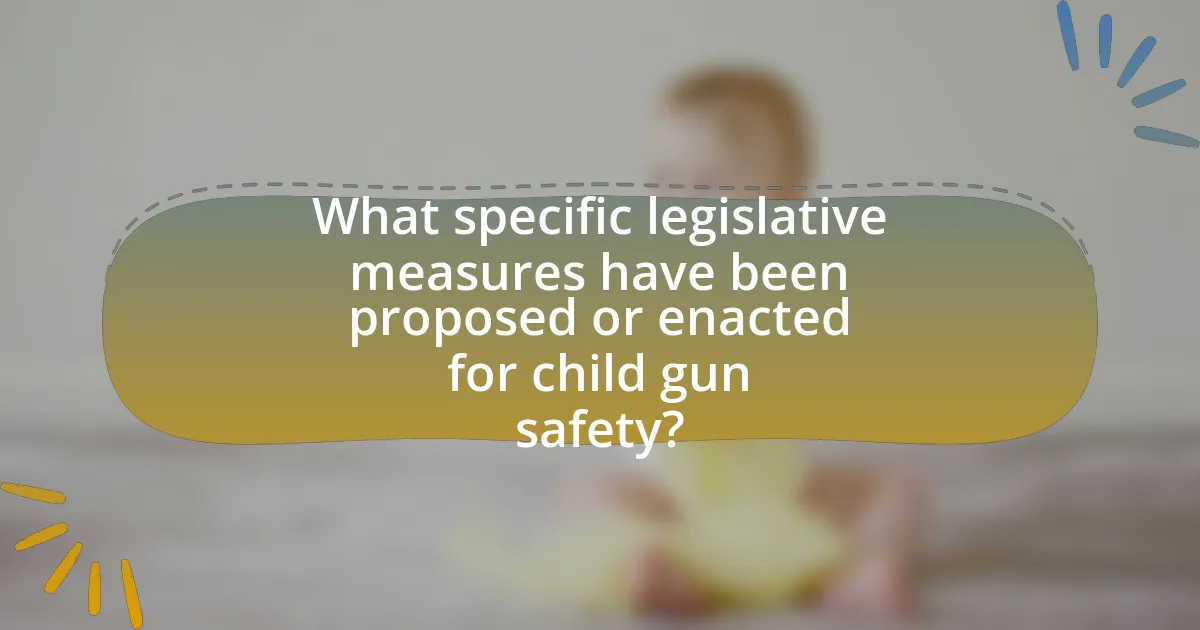
What specific legislative measures have been proposed or enacted for child gun safety?
Specific legislative measures proposed or enacted for child gun safety include the Child Access Prevention (CAP) laws, which aim to hold gun owners accountable for securely storing firearms to prevent access by minors. As of 2023, 30 states and the District of Columbia have enacted CAP laws, which have been shown to reduce unintentional shootings among children. Additionally, the Bipartisan Safer Communities Act, passed in 2022, allocates funding for community-based programs focused on gun safety education for children and families. These measures reflect a growing recognition of the need for enhanced child gun safety legislation in response to rising incidents of gun-related injuries among minors.
What types of laws are most commonly advocated for child gun safety?
The types of laws most commonly advocated for child gun safety include safe storage laws, background checks for gun purchasers, and restrictions on access to firearms by minors. Safe storage laws require gun owners to securely store firearms to prevent unauthorized access, which is crucial in reducing accidental shootings among children. Background checks aim to ensure that individuals purchasing firearms do not have a history of violence or mental illness, thereby indirectly protecting children from potential harm. Additionally, laws that restrict access to firearms by minors, such as age limits for purchasing guns and regulations on carrying firearms in public spaces, further enhance child safety. These laws are supported by research indicating that states with stricter gun laws experience lower rates of gun-related deaths among children, highlighting their effectiveness in promoting child gun safety.
How do these laws vary by state or region?
Gun safety laws vary significantly by state and region, reflecting differing political climates, cultural attitudes, and advocacy efforts. For instance, states like California and New York have implemented stringent gun control measures, including mandatory background checks and restrictions on assault weapons, while states such as Texas and Florida have more permissive laws, allowing open carry and minimal regulations on firearm purchases. According to the Giffords Law Center, as of 2023, states with stronger legislative advocacy for child gun safety measures tend to have lower rates of gun-related incidents among children, highlighting the impact of these laws on public safety.
What are the intended outcomes of these legislative measures?
The intended outcomes of these legislative measures are to enhance child gun safety and reduce firearm-related incidents among minors. These measures aim to implement stricter regulations on gun storage, promote education on safe firearm handling, and increase penalties for violations related to child access to firearms. Evidence from studies indicates that states with comprehensive child access prevention laws have seen a significant decrease in unintentional shootings and suicides involving children, demonstrating the effectiveness of such legislative actions in improving safety outcomes.
How effective have these legislative measures been in improving child gun safety?
Legislative measures aimed at improving child gun safety have shown varying degrees of effectiveness. For instance, states that have enacted safe storage laws have reported a significant reduction in unintentional firearm injuries among children. A study published in the Journal of the American Medical Association found that states with such laws experienced a 13% decrease in child firearm deaths. Additionally, background check laws have been associated with lower rates of gun violence, indirectly contributing to child safety by limiting access to firearms for individuals deemed a risk. Overall, while the effectiveness can differ by region and implementation, evidence suggests that these legislative measures have positively impacted child gun safety.
What evidence exists to support the effectiveness of these laws?
Evidence supporting the effectiveness of child gun safety laws includes a significant reduction in firearm-related injuries and deaths among children in states with stricter regulations. For instance, a study published in the journal “Pediatrics” by researchers from the University of California, Davis, found that states with laws requiring safe storage of firearms saw a 13% decrease in unintentional firearm deaths among children. Additionally, the Centers for Disease Control and Prevention reported that states implementing background checks for all gun sales experienced a 15% reduction in gun homicides. These statistics demonstrate a clear correlation between legislative measures and improved child safety outcomes regarding firearms.
How do advocates measure the success of child gun safety legislation?
Advocates measure the success of child gun safety legislation primarily through the reduction in firearm-related injuries and deaths among children. They analyze statistical data from sources such as the Centers for Disease Control and Prevention (CDC) and the National Vital Statistics Reports, which provide evidence of trends in child gun fatalities before and after the implementation of specific laws. Additionally, advocates assess compliance rates with safety regulations, such as the use of gun locks and safe storage practices, as well as the increase in public awareness and education initiatives related to gun safety. These metrics collectively indicate the effectiveness of legislation in enhancing child safety regarding firearms.
What are the potential consequences of failing to advocate for child gun safety measures?
Failing to advocate for child gun safety measures can lead to increased rates of firearm-related injuries and deaths among children. Statistics indicate that in the United States, approximately 3,000 children are killed or injured by guns each year, highlighting the urgent need for effective safety measures. Without advocacy, there is a lack of legislative action to implement safe storage laws, educational programs, and community awareness initiatives, which are proven to reduce accidental shootings and suicides involving firearms. The absence of these measures perpetuates a cycle of preventable tragedies, affecting families and communities nationwide.
How does the lack of legislation impact child safety statistics?
The lack of legislation significantly increases child safety risks, as evidenced by higher rates of firearm-related injuries and deaths among children. For instance, states with weaker gun laws report a 64% higher rate of child firearm deaths compared to those with stricter regulations, according to a study published in the Journal of the American Medical Association. This correlation indicates that the absence of comprehensive legislative measures directly contributes to increased vulnerability of children to gun violence, thereby negatively impacting overall child safety statistics.
What long-term effects could arise from inadequate advocacy?
Inadequate advocacy can lead to significant long-term effects on child gun safety measures, including increased rates of gun-related injuries and fatalities among children. Research indicates that states with weaker advocacy for gun safety legislation experience higher incidences of gun violence; for instance, a study published in the American Journal of Public Health found that states with more permissive gun laws had a 64% higher rate of firearm deaths among children compared to those with stricter regulations. Additionally, inadequate advocacy can result in a lack of funding for educational programs aimed at promoting safe gun practices, further exacerbating the risks to children. Over time, this can create a culture of normalization around gun violence, making it more challenging to implement effective safety measures in the future.
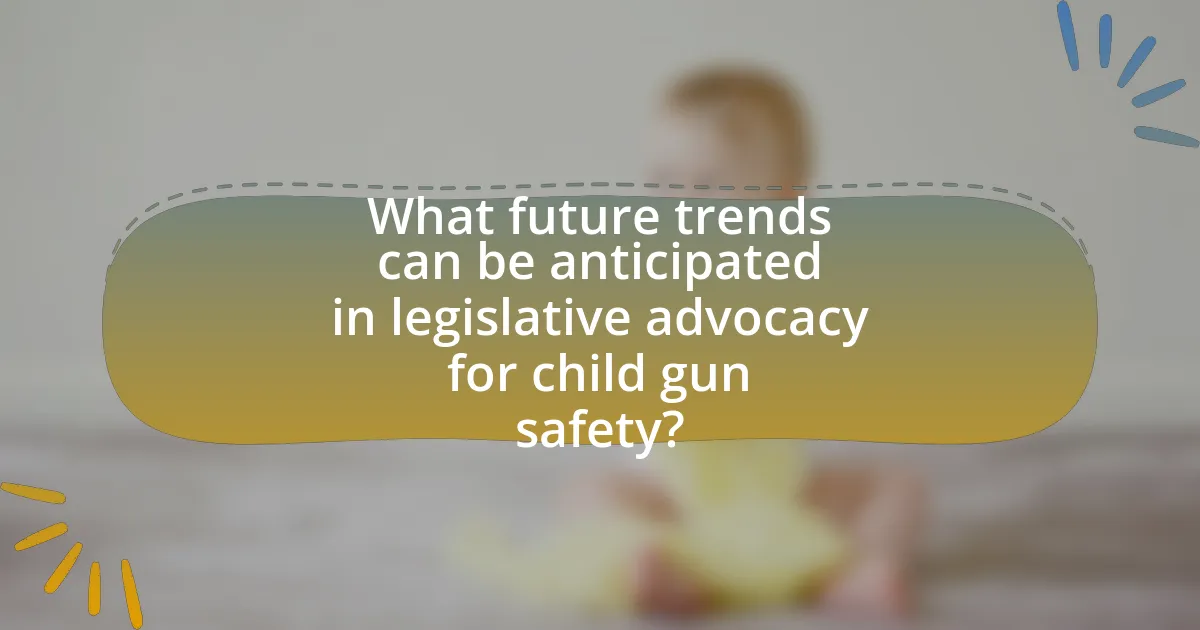
What future trends can be anticipated in legislative advocacy for child gun safety?
Future trends in legislative advocacy for child gun safety will likely include increased collaboration between advocacy groups and policymakers, a focus on data-driven approaches to legislation, and the integration of technology in safety measures. Advocacy organizations are expected to strengthen partnerships with lawmakers to promote comprehensive gun safety laws, as evidenced by the rise in coalitions such as Everytown for Gun Safety, which has successfully influenced state-level legislation. Additionally, the use of empirical data to support legislative proposals is becoming more prevalent, with studies indicating that states with stricter gun laws have lower rates of gun-related deaths among children. Furthermore, the incorporation of smart gun technology and safety features in firearms is anticipated to gain traction, as legislative bodies explore innovative solutions to enhance child safety.
How might public opinion shift regarding child gun safety in the coming years?
Public opinion regarding child gun safety is likely to shift towards greater support for stricter regulations in the coming years. This shift may be influenced by increasing awareness of gun-related incidents involving children, as evidenced by data from the Centers for Disease Control and Prevention, which reported that firearm-related deaths among children have risen significantly over the past decade. Additionally, advocacy efforts from organizations such as Everytown for Gun Safety and the March for Our Lives movement have heightened public discourse around the issue, leading to a growing demand for legislative action. As more communities experience the impact of gun violence, public sentiment may increasingly favor measures such as safe storage laws and background checks, reflecting a collective desire to enhance child safety.
What factors could influence these shifts?
Factors that could influence shifts in child gun safety measures include public opinion, legislative changes, advocacy efforts, and research findings. Public opinion can sway lawmakers to prioritize child safety legislation, as seen in states where increased awareness of gun violence has led to stricter laws. Legislative changes, such as the introduction of new bills or amendments, can directly impact the effectiveness of existing measures. Advocacy efforts by organizations focused on child safety can mobilize communities and influence policymakers, exemplified by campaigns that have successfully lobbied for enhanced safety regulations. Additionally, research findings that highlight the correlation between gun safety measures and reduced child injuries can provide compelling evidence for legislative action, as demonstrated by studies published in journals like Pediatrics, which show that states with stricter gun laws have lower rates of firearm-related injuries among children.
How can advocates prepare for these changes?
Advocates can prepare for changes in child gun safety measures by staying informed about legislative developments and engaging in continuous education on gun safety issues. This preparation involves monitoring proposed bills, understanding the implications of new laws, and collaborating with experts in child safety and gun policy. Research indicates that informed advocacy can lead to more effective policy outcomes, as seen in successful campaigns that resulted in stricter gun regulations in various states. By utilizing data and case studies, advocates can strengthen their arguments and mobilize community support, ensuring they are well-equipped to address the evolving landscape of gun safety legislation.
What innovative strategies are emerging in legislative advocacy for child gun safety?
Innovative strategies emerging in legislative advocacy for child gun safety include grassroots mobilization, data-driven policy proposals, and coalition-building among diverse stakeholders. Grassroots mobilization leverages community engagement to raise awareness and influence lawmakers, exemplified by campaigns like March for Our Lives, which has successfully advocated for stricter gun laws. Data-driven policy proposals utilize research and statistics to support legislative changes, such as studies showing the correlation between safe storage laws and reduced child firearm injuries. Coalition-building involves uniting various organizations, including health professionals, educators, and gun safety advocates, to create a unified front that amplifies their message and increases legislative pressure. These strategies collectively enhance the effectiveness of advocacy efforts aimed at improving child gun safety measures.
How are technology and social media being utilized in advocacy efforts?
Technology and social media are utilized in advocacy efforts by enabling rapid communication, mobilization, and awareness-raising among supporters. For instance, platforms like Twitter and Facebook allow organizations to disseminate information quickly, engage with the public, and organize events or campaigns effectively. A notable example is the use of hashtags such as #NeverAgain, which emerged from the Parkland shooting advocacy, mobilizing thousands to advocate for gun safety legislation. Research indicates that social media campaigns can significantly increase public engagement and influence legislative outcomes, as seen in various advocacy efforts aimed at child gun safety measures.
What role do grassroots movements play in shaping future legislation?
Grassroots movements play a crucial role in shaping future legislation by mobilizing community support and influencing policymakers. These movements often raise awareness about specific issues, such as child gun safety, by organizing campaigns, rallies, and educational initiatives that highlight the need for legislative change. For instance, the grassroots campaign “March for Our Lives,” initiated by students after the Parkland shooting, successfully advocated for stricter gun control measures, demonstrating how collective action can lead to legislative proposals and reforms. Research indicates that grassroots efforts can significantly impact public opinion and legislative agendas, as seen in various states where local advocacy has led to the introduction of bills aimed at enhancing child gun safety.
What practical steps can individuals take to support legislative advocacy for child gun safety?
Individuals can support legislative advocacy for child gun safety by actively engaging in grassroots campaigns, contacting their elected representatives, and participating in community discussions. Grassroots campaigns often involve organizing or joining local groups that focus on gun safety legislation, which can amplify voices and influence policymakers. Contacting elected representatives through emails, phone calls, or in-person meetings allows individuals to express their concerns and advocate for specific policies, such as universal background checks or safe storage laws. Additionally, participating in community discussions raises awareness and educates others about the importance of child gun safety, fostering a collective effort towards legislative change. Research indicates that community engagement and direct communication with lawmakers significantly increase the likelihood of legislative action on gun safety issues.
